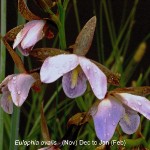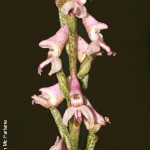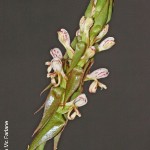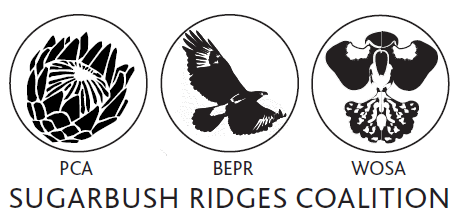Gauteng Eulophia species plus a Disa and a Satyrium
Eulophia ovalis, Disa aconitoides, Satyrium cristatum
This article will describe the Eulophia ovalis (pink flowers), the distinctive and fairly rare Disa aconitoides and a version of the fairly widespread Satyrium cristatum. There are in fact 4 species each of Disa and Satyrium that have been recorded historically in Gauteng, but those covered in this article are the only species that still appear to be locatable.
Eulophia ovalis
The Eulophia ovalis should not be confused with the Eulophia bainsii, previously known as Eulophia ovalis, ssp bainsii, which will be covered in the next article. The outer sepals are purple-maroon in colour, whereas the latter species are a pale cream-yellow. The flower spike, which holds between 7 and 18 flowers, grows to an average of about 40cm and the leaves are fully developed at this point.
Disa aconitoides
The species is quite distinctive and there are no other similar species. It grows to a height of around 370mm and carries between 20 and 50 flowers. The colour of the flowers range from off-white to flushed mauve, or even greenish, with mauve dots or speckles. The lip has a central solid mauve line.
Satyrium cristatum
This species grows up to about 400mm and has 2 distinct basal leaves. Between 25 to 60 flowers emerge from the centre of the leaves. The flowers are white and are lined with blotched to brownish red. It has sometimes been confused with well marked colour forms of Sat longicauda. There are also 2 variants, being cristatum and longilabiatum, which can be separated due to the latter species having flowers that emerge as separate shoots alongside the leaves.
Credits and refrences
Article and photographs by Duncan Mc Farlane
Proof-read and edited by Karsten Wodrich




